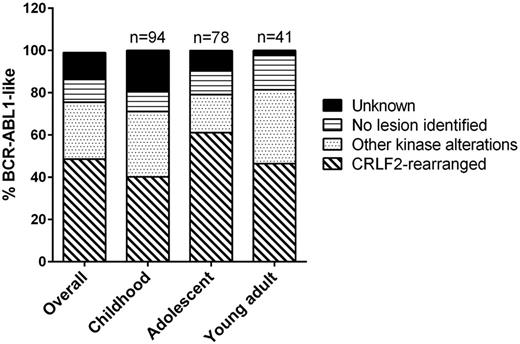Abstract
BCR-ABL1-like B-progenitor acute lymphoblastic leukemia (B-ALL) accounts for 10-15% of childhood B-ALL and is characterized by alteration of IKZFI, a gene expression profile similar to BCR-ABL1 ALL and poor outcome. Using next-generation sequencing, we have shown that BCR-ABL1-like ALL patients harbor genetic alterations activating kinase pathways that are sensitive to tyrosine kinase inhibitors (TKIs), and have shown that refractory BCR-ABL1-like ALL is responsive to TKIs in vivo (Weston et al., J. Clin. Oncol 2013). Furthermore, the outcome of ALL in adolescent and young adult (AYA) patients is inferior to children, yet the genetic basis underlying treatment failure is poorly understood.
To define the frequency and genomic landscape of BCR-ABL1-like ALL in children, adolescents, and young adults we have extended our studies to include 665 high-risk childhood (<16 years, 14% BCR-ABL1-like), 370 adolescent (16-21 years, 21% BCR-ABL1-like) and 161 young adult (21-39 years; 26% BCR-ABL1-like) B-ALL cases from the Children's Oncology Group, St Jude Children's Research Hospital, Eastern Cooperative Oncology Group, MD Anderson Cancer Center and the Alliance - CALGB trials. Event-free survival (EFS) for BCR-ABL1-like cases was inferior to non BCR-ABL1-like cases with 5-year EFS rates of 40.0±7.1 vs 85.0±3.3 (p<0.0001) for adolescent cases and 16.1±8.5 vs 57.9±8.0 (p=0.006) for young adult cases. In each age group, 50-60% of BCR-ABL1-like cases harbored rearrangements of CRLF2 (IGH@-CRLF2 or P2RY8-CRLF2) (Fig. 1).
To characterize the full spectrum of kinase lesions in the remaining BCR-ABL1-like ALL cases we performed mRNA-seq on pediatric (n=39), adolescent (n=21) and young adult (n=22) cases, and whole genome (WGS; n=18) or exome sequencing (n=10) on cases with matched tumor and normal material. Fusion transcripts were identified using deFuse and CICERO, a novel assembly-based structural variation detection method specifically designed for mRNA-seq analysis. We identified 23 different kinase rearrangements involving 7 tyrosine kinase or cytokine receptor genes. These consist of 5 ABL1, 2 PDGFRB, 8 JAK2 fusions and 2 EPOR translocations to IGH@ and IGK@ loci, along with new fusions involving the tyrosine kinases ABL2 (n=3), CSF1R (n=1), AKT2 (n=1) and STAT5B (n=1). We performed frequency testing for 15 of these fusions on 555 cases from the COG AALL0232 trial of high-risk B-ALL. Several alterations were recurrent in BCR-ABL1-like ALL, including NUP214-ABL1, RCSD1-ABL2, SSBP2-CSF1R, PAX5-JAK2 and EPOR translocations. Notably, we did not identify any of these fusions in non BCR-ABL1-like cases. The frequency of ABL1/ABL2 and EPOR translocations was consistent across all age groups (∼16% and 7% of BCR-ABL1-like cases, respectively), while JAK2 rearrangements were more common in young adult than in pediatric and adolescent ALL (12%). Importantly, ∼10% of BCR-ABL1-like ALL cases lacked a kinase-activating alteration on analysis of mRNA-seq data. Notably, we identified two additional cases with IL7R or SH2B3 sequence mutations, indicating the requirement for complementary approaches such as WGS to fully define the genomic landscape of BCR-ABL1-like ALL.
Hunger:Bristol Myers Squibb: Consultancy.
Author notes
Asterisk with author names denotes non-ASH members.


This feature is available to Subscribers Only
Sign In or Create an Account Close Modal